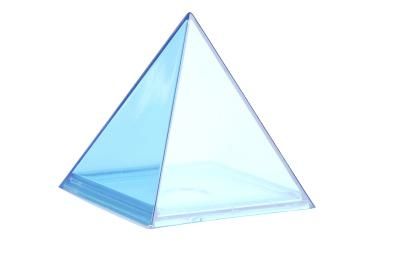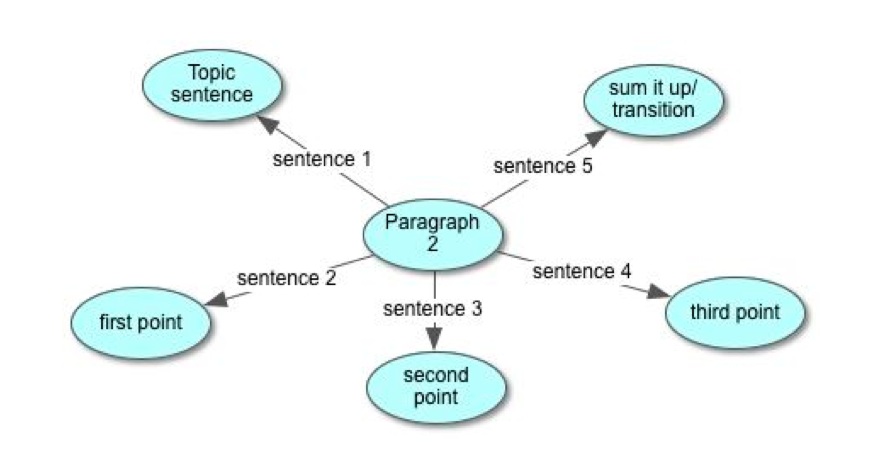
Instructional Materials for Craig White's Literature Courses
|
Check-Sheet for Essay
Organization:
|
 |
Thesis statement, topic sentences, and supporting sentences are the three main organizational elements of an academic or policy paper. Developing, organizing, and editing these elements gives you a way to quality-check your own writing instead of hoping your old magic might work this time or that the instructor is an easy grader. Details follow, but first a visual aid below that is meant to correspond to the pyramid above:
|
Thesis Statement |
|
|
 |
 |
|
|
Topic Sentences:
usu. first 1-2 sentences per body
3 functions: 1. main idea of 2. connection to thesis 3. transition from previous |
|
Topic Sentence for Body Paragraph 1 |
Topic Sentence for Body Paragraph 2 |
Topic Sentence for Body Paragraph 3 |
Topic Sentences for additional Body Paragraphs |
|
|
 |
 |
|
|
Supporting Sentences
Usually interior sentences of facts, quotations, testimony, examples, analysis, commentary. |
|
Supporting Sentences for Body |
Supporting Sentences for Body |
Supporting Sentences for Body |
Supporting Sentences for other Body |
![]()
Thesis Statements (details) |
 http://www.professays.com/thesis/ thesis-statement/ |
Thesis Statement
Importance: Writing and Literature instructors insist on an identifiable and functional thesis statement. Other instructors may know less about writing, but if they feel confused about your point or purpose, they might ask, "Where's your thesis statement?"—suggesting that if you can't show them your central or defining point, your paper is in some kind of trouble.
More positively, a strong, purposeful, well-written thesis statement interests your reader and drives your paper. When you're developing your paper and wondering what to put in or leave out, a standard test is to ask yourself, "How does this help my thesis—or not?" (If the idea or point seems interesting but doesn't directly help or support your thesis, an alternative to throwing it out is to ask if the thesis might be enlarged or redeveloped so the new material fits.)
Length: A thesis statement is not necessarily one sentence, though early writing instruction often teaches it that way. Anything's possible in writing, but a thesis statement is usually from 1 to 3 sentences. The length of the thesis statement may vary with the length of your paper and its introduction. For the entry-level 5-paragraph essay, the introduction is one paragraph and the thesis statement may be only one sentence. But for longer papers, the introduction may be 2-3 paragraphs and the thesis statement 2-3 sentences—but these proportions aren't strict and can vary with the situation.
Location: Default position for a thesis statement is at the end of the introduction, just before the paper's body paragraphs begin. For very short essays (like an ID question on an essay exam), the very first sentence may serve as a thesis statement.
No rules are absolute. Good writing may always find reasons to change, but balance the risk.
The rationale for having a thesis at the end of the introduction is that the first part of the introduction "introduces" or familiarizes your reader with your subject and stimulates his or her interest and makes the subject matter.
These backgrounds should lead to your thesis or overall point you're making about the subject. Think of your thesis statement as the "climax" or "finale" of your introduction.
Functions or Content: Your essay's thesis states the idea, point, or theme to which all your paper's elements directly or indirectly connect. Putting the thesis at the end of the introduction sets it up for the body paragraphs to discuss.
Two main options for what a thesis does:
-
organization
or
-
theme, insight, verdict
High-quality theses do both.
*Organization thesis: Your thesis might indicate an organization of elements to be discussed. For instance, in the classic academic 5-paragraph essay (which we're not limited to), a thesis often lists 3 items or sub-points, which three body paragraphs discuss one at a time, followed by a one-paragraph conclusion. For an essay on your writing experience, a three-item thesis might say, "Throughout my writing career I have faced difficulties with grammar, organization, and style," creating expectations that the first body paragraph will deal with grammar, the 2nd with organization, and the 3rd with style.
-
Advantages to organization-thesis: easy to teach, easy to test. As long as you can come up with a list of sub-topics, you're in business. The reader knows what to expect and can follow.
-
Disadvantages to organization-thesis: lists are boring, readers just tune them out, but teachers can march through them to see if you marched through them. Lists are limited to "addition" relations instead of more sophisticated logical relations like cause-and-effect.
*Theme, insight, verdict-thesis: A thesis is not the subject of your essay but your point about that subject. The stronger or more compelling your point, the stronger your thesis and essay.
How about both? Begin the thesis statement with the range of sub-points (e.g., grammar, organization, style) to be covered, then add a final sentence that unifies these diverse materials into an overall point. Hooray!
How to write a thesis statement: The short answer is to draft and re-draft as you develop your essay.
The longer answer is that your thesis can and should change as you develop the body of your paper.
Test your thesis and the body paragraphs against each other.
-
Are the paragraphs proving my thesis or proving something else?
-
Is my thesis adequate to what my body paragraphs are doing?
-
If not, does my thesis need expanding or sharpening? Or should I change my paragraphs?
Don't expect to get your thesis statement right on your first draft. In early drafts, many writers regard their thesis as "a working thesis." A working thesis is like a hypothesis—"a proposition or principle put forth merely as a basis for reasoning or argument" (OED)—that will take form, crystallize, develop or evolve as they continue to think about or work with it.
 |
Metaphor: your introduction is a funnel that narrows to its thesis and
to the body of the paper, which follows the straight line of the thesis
like a graduated cylinder or beaker like you might see in a
laboratory. Start your introduction broadly with your general subject, narrowing down to a thesis or point about the subject. |
 http://www.openschool.bc.ca/courses/families10-12/fsp/html/writ_multipara001.html |
For instance, an introductory paragraph for Essay 1 on Writing
Experience might open with a broad statement establishing the subject like,
"Throughout my
career as a student, writing has been held up as the holy grail of
[or key to] academic success . . . ," followed by explanations or illustrations
of how this perception came through, maybe with the idea that once you
learned the right tricks, you could cruise.
Then, after that subject is set up, your thesis might be something like, "As a result of these experiences, I now see that writing is not like the Holy Grail, which, once you see it, you're done and delivered from all struggles once and for all. Instead, writing is something where each assignment is a new experience you must think through in order to learn how to write aobut it. You can't forget what you learned before, but for each particular assignment you have to rethink what works and what doesn't. The downside is that you have to keep working, but the upside is you always keep learning."
![]()
Body Paragraphs (details) |
 http://bitsofwisdomforall.com/2011/06/01/easy-steps-to-master-the-5-paragraph-essay-2/ |
Paragraph lengths: for academic writing, most paragraphs run 4-7 sentences long, but lengths can vary, especially relative to sentence length.
Paragraphs in popular writing (especially newspapers) usually run shorter (but not always).
Paragraph
structure:
![]()
Topic Sentence: Usually the first sentence (sometimes two sentences) of a paragraph. The topic sentence is usually a fairly long sentence because it has to perform three functions:
1. state main idea of paragraph
2. connect to thesis or main point
3. provide
transition* from previous paragraph
(more on
![]() transitions below)
transitions below)
Why are topic sentences so important?
-
They appear just when your reader's attention is strongest and freshest. Your reader has just finished a paragraph, rested briefly to recharge, and is ready to see what's next and accept pointers.
-
The three functions of the Topic Sentence constitute the connective tissue of your essay, sending out lines of relation to the thesis at the top of the essay, to the paragraph just before, and to the supporting sentences just below.
How to write a topic sentence: As the Thesis Statement develops in relation to the body of the paper, the Topic Sentence develops in relation to the supporting sentences, the thesis, and the previous paragraph.
Therefore, as with a thesis statement, don't necessarily expect to get a topic sentence right on the first try. Instead, start a "working topic sentence" that can get the paragraph going, then keep double-checking and revising according to the following questions:
-
Does the Topic Sentence clearly state the point that is developed or supported by the Supporting Sentences? If not, you can revise your Topic Sentence, your Supporting Sentences, or both.
-
Does the Topic Sentence connect to the thesis statement? What may be obvious to you may not be obvious to your reader. Make sure the connection is definite, as in a key word or concept that your reader will immediately recognize as related to your thesis.
-
Does your Topic Sentence make a transition from the previous paragraph? Can your reader see how the point you're making in this paragraph directly follows the point you made in your previous paragraph? If not, look for chances to reflect back on the previous paragraph with a transition, a repetition, a comparison or contrast, or some other logical connection.
![]()
Usually the interior sentencesof the paragraph that support or develop the topic sentenceof the paragraph that support or develop the topic sentence
Content: facts, logic, quotations, citations, testimony, examples, analysis, commentary, second thoughts, reflections.
Supporting sentences tend to be more concrete and particular, while the topic sentence tends to be more abstract or thematic and general.
Advice for making sentence-to-sentence reading readable + thematic continuity or transition:
-
Keep subjects near the front of the sentence. Avoid long introductory prepositional phrases or dependent clauses.
-
Keep the subject (of the verbs) consistent from sentence to sentence, or manage shifts so reader can follow.
![]()
If your paragraph becomes so long that its main idea or point gets lost or confused on the way through your supporting sentences, try a wrap-up sentence that summarizes where you’ve arrived and returns to and refocuses the main idea of the Topic Sentence.
Warning: Some students are taught to use a paragraph's concluding sentence to make a transition to the next paragraph. This may work sometimes but isn't standard practice. Transition is almost always optimal after a paragraph shift, not before the shift.a paragraph shift, not before the shift.
![]()
 |
Transitions |
 |
3 ways of making
transition:
(non-exclusive—all 3 may work in a single unit of thought)
1. transition by repetition of key words or concepts
Students often learn not to repeat themselves, but some repetition (at intervals) is desirable for refocusing or re-centering your line of thought.
Example: Public speakers obviously repeat key words to remind people of their subject, theme, or emphasis.
In essays, Topic Sentences may connect with the thesis by repeating key words or obvious synonyms from the thesis statement, and make transition from the previous paragraph by referring to one of its key words or concepts.)
2. transition by demonstrative pronouns and adjectives
this, that, these, those; such
For instance, if your previous paragraph pointed out a common error, you could start the next paragraph with "This error . . . " or "Such a misconception . . . ," then shift to your next point in developing your thesis, maybe an analysis or solution to this error.
3. transition by using “transitional” or “signal” words and phrases
These are the most obvious forms of transition and the most easily learned, but the first two
can be more subtle and may stick closer to your thesis.)
causation / logic: because, therefore, since, thus, as a result, consequently
contrast: but, however, yet, in contrast
sequence: then, next, following, before, etc.
addition: and, in addition, also, further, another, finally, first-second-third (be careful of this option—often piling on examples, as I may be doing now . . . )
For more examples, see website / handout on Transitions.
